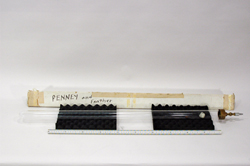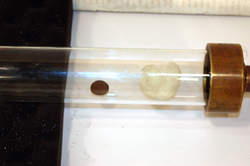|
Size: 3410
Comment:
|
← Revision 15 as of 2019-08-01 18:13:54 ⇥
Size: 4062
Comment:
|
| Deletions are marked like this. | Additions are marked like this. |
| Line 2: | Line 2: |
| ||<:30%>[:PiraScheme#Mechanics: Table of Mechanics Demonstration]||<:30%>[:MEEquipmentList: List of Mechanics Equipment & Supplies]||<:30%>[:Demonstrations:Lecture Demonstrations]|| | ||<30% style="" & quot;text-align:center& quot; " ">[[PiraScheme#Mechanics|Table of Mechanics Demonstration]] ||<30% style="" & quot;text-align:center& quot; " ">[[MEEquipmentList|List of Mechanics Equipment & Supplies]] ||<30% style="" & quot;text-align:center& quot; " ">[[Demonstrations|Lecture Demonstrations]] || |
| Line 5: | Line 6: |
| '''Topic and Concept:''' . Motion in One Dimension, [[MotionIn1D#UniformAcceleration|1C20. Uniform Acceleration]] '''pira200 Listed''' |
|
| Line 7: | Line 13: |
| * '''Cabinet:''' [:MechanicsCabinet:Mechanic (ME)] * '''Bay:''' C3 |
* '''Cabinet:''' [[MechanicsCabinet|Mechanic (ME)]] * '''Bay:''' A4 |
| Line 11: | Line 18: |
| attachment:PennyCottonSetup-01-400.jpg | {{attachment:PennyCottonSetup-01-400.jpg}} |
| Line 13: | Line 20: |
| '''Description:''' | '''Abstract:''' |
| Line 16: | Line 23: |
| ||<40% style="" & quot; & amp; quot; ;text-align:center& quot; " ">'''Equipment''' ||<30% style="" & quot;text-align:center& quot; " ">'''Location''' ||<25% style="" & quot;text-align:center& quot; " ">'''ID Number''' || || || || || ||Penny and Cotton Tube ||ME, Bay A4, Cubby ||1C20.10 || ||[[VacuumPump|Vacuum Pump]] ||ME, Floor Item, South wall ||2A.EQ.100 || |
|
| Line 17: | Line 28: |
| ||<:style="width: 60%" :40%>'''Equipment'''||<:30%>'''Location'''||<:25%>'''ID Number'''|| || || || || ||Penny and Cotton Tube||ME, Bay C3, Cubby||1C20.10|| ||[:VacuumPump:Vacuum Pump]||ME, Floor Item, South wall||2A.EQ.100 || |
|
| Line 22: | Line 29: |
| '''''Important Setup Notes:''''' | |
| Line 24: | Line 30: |
| N/A | |
| Line 26: | Line 31: |
| '''Setup:''' | '''''Important Setup Notes:''''' |
| Line 28: | Line 33: |
| 1. Make a Setup check list. 1. ... |
* N/A '''Setup and Procedure:''' 1. Either have the glass tube in its box until use or have a soft mount ready on the table to place the tube on. 1. For pump setup, see vacuum pump page linked above. 1. Place both objects at one end of the tube at atmospheric pressure, and then rapidly invert the tube. Note that the two objects fall at different rates in air. 1. Again, place both objects at one end of the tube. 1. Evacuate the tube by using the vacuum pump, and then rapidly invert the tube. Note that both objects now fall at the same. |
| Line 32: | Line 44: |
| 1. The tube is fragile. Handle with care. | |
| Line 34: | Line 45: |
| * The tube is fragile. Handle with care. | |
| Line 35: | Line 47: |
| '''Demonstration:''' | '''Discussion:''' |
| Line 37: | Line 49: |
| Show that all objects would fall at the same rate were it not for air resistance. Invert the tube once, and then again when evacuated. A glass tube at least a meter in length is equipped with a valve and nozzle through which the tube can be evacuated with a vacuum pump. Such a tube is called a guinea and feather tube because those were the objects traditionally used when the demonstration was performed in England centuries ago. The guinea was an English gold coin issued from 1663 to 1813 and valued at 21 shillings. In this tub, a modern coin and a ball of cotton are used. Our penny is so old that the edge of the penny is distorted for the years of use. |
A glass tube at least a meter in length is equipped with a valve and nozzle through which the tube can be evacuated with a vacuum pump. Such a tube is called a guinea and feather tube because those were the objects traditionally used when the demonstration was performed in England centuries ago. The guinea was an English gold coin issued from 1663 to 1813 and valued at 21 shillings. In this tub, a modern coin and a ball of cotton are used. Our penny is so old that the edge of the penny is distorted from the years of use. |
| Line 44: | Line 53: |
| Places both objects at one end of the tube at atmospheric pressure. Then rapidly inverts the tube, yielding the expected result. Then evacuated the tube by use of a ruffing pump, and the demonstration is then repeated. Note now that both objects fall at the same rate when the tube is evacuated. Of course, the part of the demonstration not requiring a vacuum can be done without use of the tube with the demonstrator standing on the lecture table for a bit of extra drama. If a vacuum pump is not available, an alternate form of the demonstration can be done using a heavy book and a sheet of paper (smaller than the book)[1]. The two are first dropped side by side. The book will fall much faster. The paper is then placed flat on top of the book and the two are released together. They will fall at the same rate because the book eliminates the air resistance that the paper would otherwise experience. |
If a vacuum pump is not available, an alternate form of the demonstration can be done using a heavy book and a sheet of paper (smaller than the book)[1]. The two are first dropped side by side. The book will fall much faster. The paper is then placed flat on top of the book and the two are released together. They will fall at the same rate because the book eliminates the air resistance that the paper would otherwise experience. || {{attachment:PennyCotton-01-250.jpg}} || {{attachment:PennyCotton-06-250.jpg}} || {{attachment:PennyCotton-05-250.jpg}} || |
| Line 49: | Line 57: |
| ||attachment:PennyCotton-01-250.jpg||attachment:PennyCotton-06-250.jpg||attachment:PennyCotton-05-250.jpg|| | '''Videos:''' * [[https://www.youtube.com/watch?v=DqSCOjGuKEk|Penny and Feather, 1C20.10]] * [[https://www.youtube.com/user/LectureDemostrations/videos?view=1|Lecture Demonstration's Youtube Channel]] |
| Line 53: | Line 66: |
| 1. [http://sprott.physics.wisc.edu/demobook/chapter1.htm Prof. Sprott's Notes] | * [[http://sprott.physics.wisc.edu/demobook/chapter1.htm|Prof. Sprott's Notes]] |
| Line 55: | Line 68: |
[:Instructional:Home] |
[[Instructional|Home]] |
Penny and Cotton (AKA Guinea and Feather), 1C20.10
Topic and Concept:
Motion in One Dimension, 1C20. Uniform Acceleration
pira200 Listed
Location:
Cabinet: Mechanic (ME)
Bay: A4
Shelf: Cubby

Abstract:
A glass tube contains a piece of cotton ball and a penny. It is fitted with a valve on one end so that it may be attached to a vacuum pump.
Equipment |
Location |
ID Number |
|
|
|
Penny and Cotton Tube |
ME, Bay A4, Cubby |
1C20.10 |
ME, Floor Item, South wall |
2A.EQ.100 |
Important Setup Notes:
- N/A
Setup and Procedure:
- Either have the glass tube in its box until use or have a soft mount ready on the table to place the tube on.
- For pump setup, see vacuum pump page linked above.
- Place both objects at one end of the tube at atmospheric pressure, and then rapidly invert the tube. Note that the two objects fall at different rates in air.
- Again, place both objects at one end of the tube.
- Evacuate the tube by using the vacuum pump, and then rapidly invert the tube. Note that both objects now fall at the same.
Cautions, Warnings, or Safety Concerns:
- The tube is fragile. Handle with care.
Discussion:
A glass tube at least a meter in length is equipped with a valve and nozzle through which the tube can be evacuated with a vacuum pump. Such a tube is called a guinea and feather tube because those were the objects traditionally used when the demonstration was performed in England centuries ago. The guinea was an English gold coin issued from 1663 to 1813 and valued at 21 shillings. In this tub, a modern coin and a ball of cotton are used. Our penny is so old that the edge of the penny is distorted from the years of use.
One can introduce this demonstration by asking the audience which falls faster, the cotton or the penny. Whichever answer is given is either right or wrong depending upon whether the experiment is performed in the air or in a vacuum. One can point out that in science there are often opposing theories, and in such cases, experiments are required to determine which theories are correct. Actually, an experiment usually cannot prove that a theory is correct, only that it is incorrect.
If a vacuum pump is not available, an alternate form of the demonstration can be done using a heavy book and a sheet of paper (smaller than the book)[1]. The two are first dropped side by side. The book will fall much faster. The paper is then placed flat on top of the book and the two are released together. They will fall at the same rate because the book eliminates the air resistance that the paper would otherwise experience.
|
|
|
Videos:
References:


